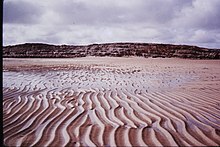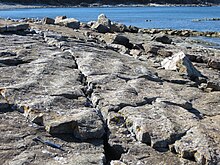
In geology, ripple marks are sedimentary structures (i.e., bedforms of the lower flow regime) and indicate agitation by water (current or waves) or directly by wind.

In geology, ripple marks are sedimentary structures (i.e., bedforms of the lower flow regime) and indicate agitation by water (current or waves) or directly by wind.
| Straight |
Straight ripples generate cross-laminae that all dip in the same direction, and lie in the same plane. These forms of ripples are constructed by unidirectional flow of the current. |
|---|---|
| Sinuous |
Sinuous ripples generate cross-laminae that are curvy. They show a pattern of curving up and down as shown in picture. Sinuous ripples produce trough cross lamination. All laminae formed under this type of ripple dip at an angle to the flow as well as downstream. These laminae are also formed by the unidirectional current. |
| Catenary |
Catenary ripples generate cross-laminae that are curvy but have a unidirectional swoop. They show a pattern similar to what a repeated "W" would look like. Like the sinuous ripples, this form of ripple is created by unidirectional flow with the dip at an angle to the flow as well as downstream. |
| Linguoid / Lunate |
Linguoid ripples have lee slope surfaces that are curved generating a laminae similar to caternary and sinuous ripples. Linguoid ripples generate an angle to the flow as well as downstream. Linguoid ripples have a random shape rather than a "W" shape, as described in the catenary description. Lunate ripples, meaning crescent shaped ripples, are exactly like linguoid ripples except that the stoss sides are curved rather than the lee slope. All other features are the same. |
| Size | Description |
|---|---|
| Very small | Very small cross-lamination means that the ripple height is roughly one centimeter. It is lenticular, wavy and flaser lamination. |
| Small | Small cross-bedding are ripples set at a height less than ten centimeters, while the thickness is only a few millimeters. Some ripples that may fit this category are wind ripples, wave ripples, and current ripples. |
| Medium | Medium cross-lamination are ripples with a height greater than ten centimeters, and less than one meter in thickness. Some ripples that may fit this category would be current-formed sand waves, and storm-generated hummocky cross stratification. |
| Large | Large cross-bedding are ripples with a height greater than one meter, and a thickness equivalent to one meter or greater. Some ripples that may fit this category would be high energy river-bed bars, sand waves, epsilon cross-bedding and Gilbert-type cross-bedding. |


|
Main article: Wave-formed ripple |
|
See also: Aeolian processes |

